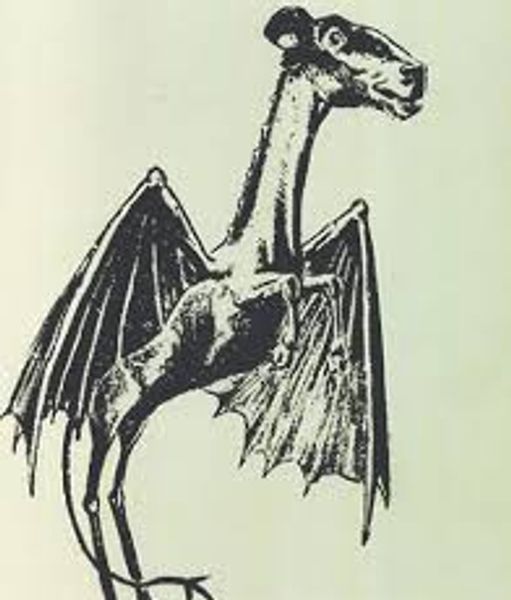
Keep your eyes peeled for the Jersey Devil
Looking for the Jersey Devil? I know where it hangs out.
One legend claims in 1735, a woman named Leeds was giving birth to her thirteenth child and exclaimed "let the child be the devil!" The child, though born normally, immediately grew wings, tail, and claws and flew out to the Pine Barrens.
According to some, the child transformed into a creature with hooves, a goat's head, bat wings, and a forked tail. Growling and screaming, the child beat everyone with its tail before flying up the chimney and heading into the pines. In some versions of the tale, Mother Leeds was supposedly a witch and the child's father was the devil himself. Some versions of the legend also state that local clergymen subsequently attempted to exorcise the creature from the Pine Barrens.
Just in case we miss it ...
NOTICE
In the unlikely event we miss a sighting of the Jersey Devil ... don't fret. There's lots of other wildlife we'll see along the ride. Adjacent to the Pine Barrens, the Edwin B. Forsythe National Wildlife Refuge protects more than 48,000 acres of southern New Jersey coastal habitats. This ride is a big favorite, with great lunch spots all along the route.

Begin our safari at the Jersey - Atlantic Wind Farm
The Jersey-Atlantic Wind Farm is the first coastal wind farm in the United States and the first such wind farm in New Jersey. It became operational in March 2006, and has five 1.5 MW turbines built by General Electric. Each wind turbine reaches a height of 380 feet. The treatment plant uses approximately 50% of the wind-generated capacity from the wind turbines, providing about 60% of the wastewater plant's electricity needs. The remaining energy is provided to the main power grid for resale as premium renewable electricity.
This stop is also available on the Pine Barrens Tour and Smithville Port Republic Joyride.

Home of Dr. Jonathan Pitney - Father of Atlantic City
We will pass the home of the “Father of Atlantic City”, Dr. Jonathan Pitney. The home was built in 1799, added to in 1848 and beautifully restored in 2015. The Jonathan Pitney house has 8 period appointed rooms and 6 suites all with private baths, gas fireplaces, air-conditioning and decorated from the early 1800's and Victorian era. Close by is Historic Smithville, Renault Winery, the famed Seaview Country Club, Forsythe Wildlife Preserve and entry to the New Jersey Pine Barrens.
This stop also available on the Pine Barrens Tour, and Smithville Port Republic Joyride.

The Edwin B. Forsythe National Wildlife Refuge
Almost 90% of Forsythe Refuge is tidal salt marsh, interspersed with shallow coves and bays. The beach areas provide fragile ecosystems for birds whose populations have already been impacted by development, so Holgate is closed to all public during the nesting season; Little Beach is closed all year except by special permit for research or education.
Each year thousands of ducks and geese, wading birds and shorebirds concentrate here during spring and fall migration, making the refuge a good site for birdwatching, nature photography and related activities. More than 3,000 acres of the refuge are woodlands. The woodlands offer a wide variety of tree and plant species, thus also providing vital habitat for a variety of upland species such as songbirds, woodcock, white-tailed deer and box turtles.

Powhatan Shipwreck Mass Grave
The Powhatan grave site in Smithville contains the burial site of 54 German immigrants who died in the wreck of the packet ship Powhatan in April, 1854. Smithville is fairly close to the ocean, but not so much that you'd think a ship was wrecked there, so why were the victims buried in this cemetery? Find out on this tour!
This stop also available on the Smithville Port Republic Joyride and the Pine Barrens Tour.

The birthplace and stomping grounds of the Jersey Devil
The town of Leeds Point is named after the Leeds family, whose first American member, Daniel Leeds, Surveyor General of West Jersey around the beginning of the 18th century, after immigrating to New Jersey from the city of Leeds in England, claimed the land which now makes up Leeds Point. Some of his descendants still live here.
The Jersey Devil was born in Leeds Point, according to one legend about the cryptid. The legend claims that in 1735, the thirteenth child of a woman called Mrs. Leeds from the community was transformed into a demon shortly after birth due to her cursing that it would be the devil. The home where the Jersey Devil was born is lived in today. See the infamous chimney from which he escaped.
In South Jersey and Philadelphia folklore, the Jersey Devil, also known as the Leeds Devil, is a legendary creature, or cryptid, said to inhabit the forests of the Pine Barrens in South Jersey.
Cryptids are animals or other beings whose present existence is disputed or unsubstantiated by science.

Chestnut Neck Privateers
At the beginning of the American Revolutionary War, Chestnut Neck was a busy thriving trade center on the Little Egg Harbor River, about 10 miles north of present-day Atlantic City. Local vessels traveled to New York and elsewhere, carrying mail, trading goods and merchandise.
With the coming of the war, American privateers took over the harbor facilities to use as a home base. They would attack and seize British ships and take their captured prizes into Chestnut Neck. The captured vessels and their cargoes were sold, and the captured vessels were often adapted for use as privateers. In addition, French aid to the Patriots may have come in through Chestnut Neck as well - supplies, ammunition, uniforms, and other provisions.
The Daughters of the American Revolution erected a 50-foot-high monument to mark the site of the Battle of Chestnut Neck and honor the men that fought there. The Minute Man at its top faces the river, "guarding the shore" against the approaching enemy. The monument was dedicated on October 6, 1911.